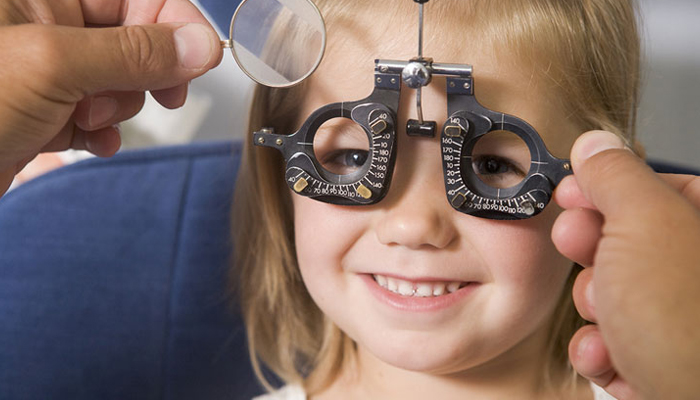Myopia Control Lens
Slow or Stop the Progression of Myopia
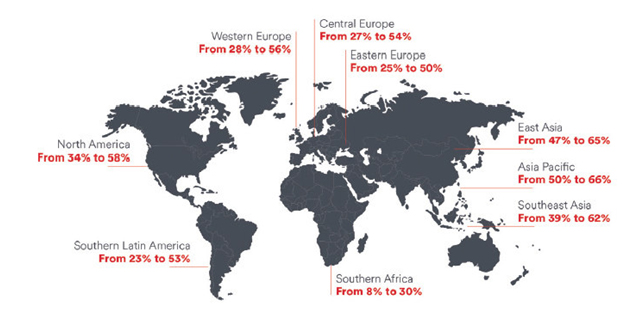
Myopia Today
Myopia, which is also known as short-sightedness or nearsightedness, is a growing problem. In fact, a recent study predicts that myopia will affect vision for nearly half of the global population by 2050.
Myopia usually begins in childhood when the eyeball grows too long, causing blurry distance vision. The condition is caused by family history, lifestyle or both. It also tends to get worse as kids get older because their eyes continue to grow. This can have a significant impact on a child’s everyday life and can sometimes lead to future eye health problems. Fortunately, new research is lighting the path to improved strategies to manage myopia in children.
Treatment to correct myopia
The standard goal of treating nearsightedness is to improve vision by helping focus light on your retina through the use of corrective lenses or refractive surgery. Managing nearsightedness also includes regular monitoring for complications of the condition, including glaucoma, cataracts, retinal tears and detachments, and damage to central retinal areas.
Wearing corrective lenses treats nearsightedness by counteracting the increased curvature of your cornea or the increased length of your eye.
Types of prescription lenses include:
- Eyeglasses - This is a simple, safe way to sharpen vision caused by nearsightedness. The variety of eyeglass lenses is wide and includes single vision, bifocals, trifocals and progressive multifocals.
- Contact lenses- These lenses are worn right on your eyes. They are available in a variety of materials and designs, including soft and rigid, gas permeable in combination with spherical, toric and multifocal designs.

If you feel comfortable with things so far, we're ready for the next step. When we correct vision with glasses or contact lenses, they help you see better because they move the image to the retina, making your eye as if it was an emmetrope (without correction). That seems like it should solve the problem, right, because emmetropes stay emmetropes, they don't tend to get worse and worse? So why do corrected myopes, wearing the correct glasses prescription, keep getting more myopic?
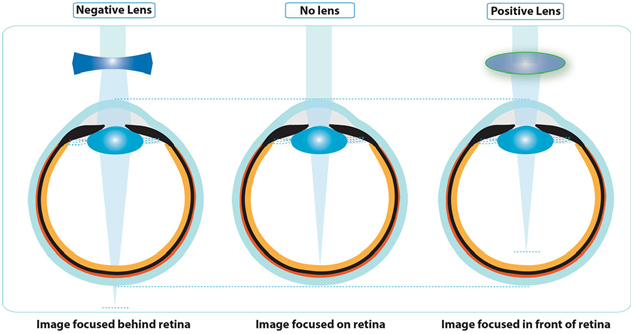
The answer in peripheral defocus theory is because we need to look away from what's going on at the central retina (where the image you are viewing is being focused) and pay attention to what's occurring peripherally in the retina. Why don't corrected myopes act exactly like emmetropes? Because they don't have the same ocular anatomy -- that's why light is focusing incorrectly in myopes in the first place. Myopes have a longer eyeball (axial length is the techinical term) which is why light falls short of the retina when it enters the eye. Correcting a myope's vision with glasses or contact lenses can make them like an emmetrope centrally where light is focused for clear visual processing, but it can't negate the fact that the eye is too long, so light is still being focused incorrectly in the peripheral retina in a myope but not in the perfect length eyeball of the emmetrope.
This image right is a favorite because it illustrates that a myope doesn't have a perfect circle for an eye -- notice how the illustration points out the move oval or prolate shape of the myopic retina -- it's stretched horizontally longer. So when light focuses clearly on that elongated central retina, it is now by default being focused behind the retina in the periphery. This is called peripheral hyperopic defocus, and it's our culprit for myopes worsening and worsening. The concept is that when these light rays fall behind the retina in the periphery, our body chemistry changes eliciting a response to make the eye increase it's axial length. The eye is programmed to want to get those peripheral light rays into focus ideally in front of the retina (called myopic peripheral defocus) where they would naturally fall in an emmetropic eye.
But the more the eye grows to try to bring those peripheral retinal images into focus, the higher the myopic prescription gets, and we enter a constant feedback loop of the eye getting more and more nearsighted. We know from studies performed on chicks that myopic defocus induces choroidal thinning and axial length growth within a very short amount of time (within just 5 hours of a chick wearing a minus lens, researchers were seeing changes). Interestingly these same studies show that it doesn't matter the amount of hyperopic defocus induced, just the fact that it's there. Whether the chicks were wearing a -5.00D lens or a -15.00D lens, their eye grew by about the same length.
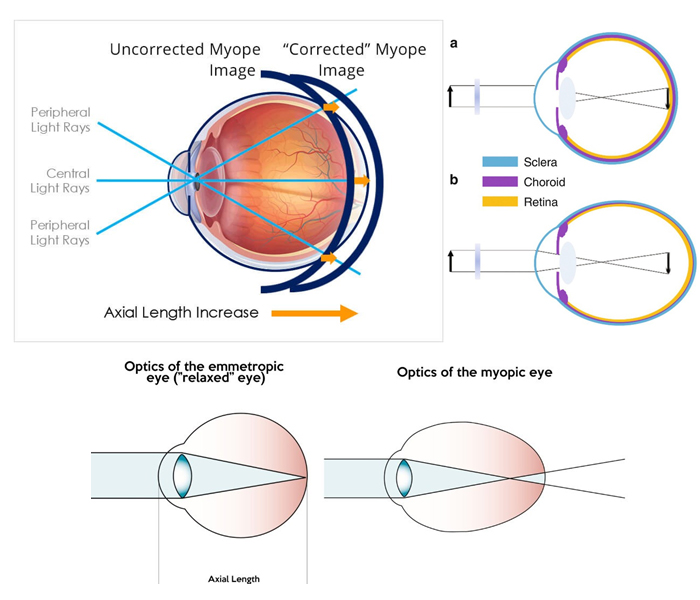
Treatments to slow or stop progression of nearsightedness
Researchers and clinical practitioners continue to seek more-effective approaches to stop nearsightedness from getting worse over time. Therapies that show the most promise to date include:
1. Put the devices away.

Data from 145 studies covering 2.1 million participants revealed that increases in myopia are driven principally by lifestyle.Today’s youth spend a lot of time performing near work activities, often on electronic devices. Of course it’s unrealistic to ask kids not to use these tools at all, but try to limit them so that there’s more balance in your child’s day.
2. Send kids outside.

Kids spend a lot of time indoors at home and in classrooms, so whenever possible, try to plan more outdoor activities. Researchers suggest that myopia progression may be caused by light levels, which may be directly related to how little time kids spend outdoors nowadays. In fact, according to the Vision Council, nearly one in four kids spend more than three hours per day using digital devices, when they might be better off heading outside for some good old-fashioned play. Increased outdoor activity has been shown to retard the onset of myopia by 11-34%.One possible reason for this is because components of sunlight activate vitamin D, which may play a potential role in eye growth. Also, kids are usually engaged in more distance-vision activities when they’re outside, which places fewer strenuous near-vision demands on young eyes
3. Ask your doctor about ways to manage myopia.
1. The topical medication, atropine
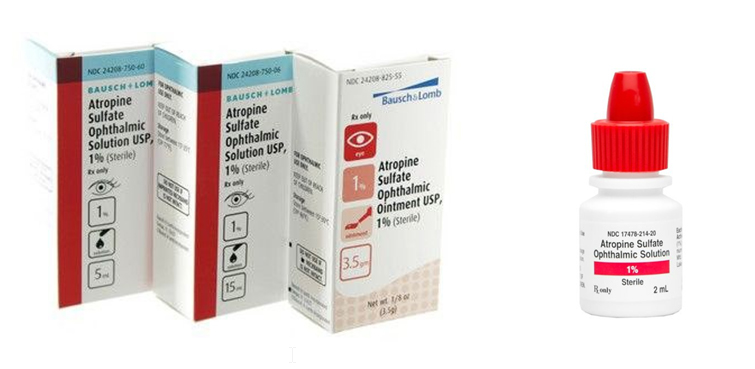
2. Dual focus contact lenses.
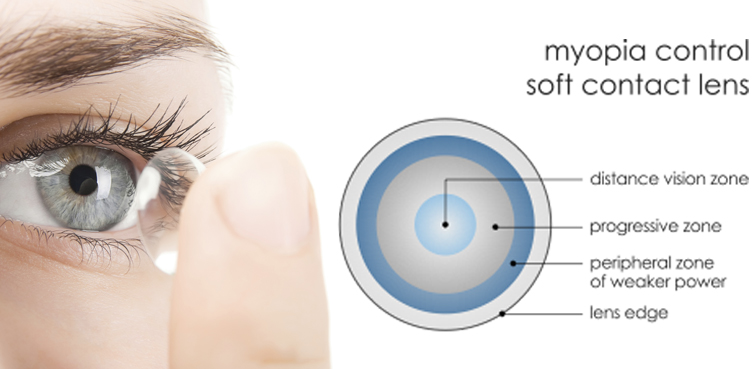
3. Orthokeratology
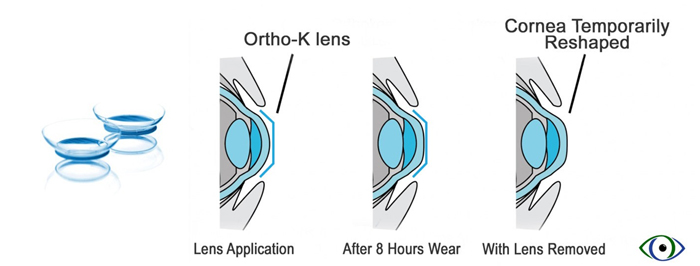
Myopia Control Eyeglasses Lenses
It is an innovative spectacle lens for myopia control, and designed for teenagers under 18. It uses three core technologies to control myopia progression, and provides clear vision and myopic defocus simultaneously at all viewing distances.
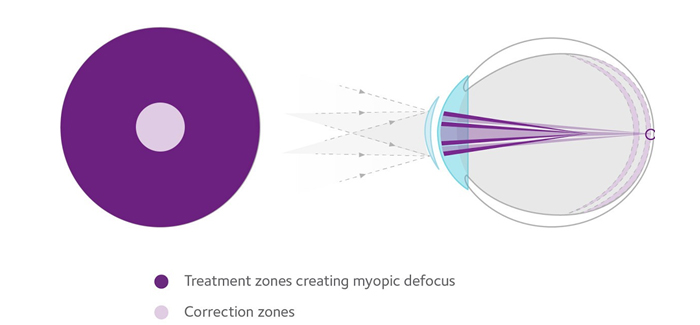
(1) How do the myopia control lenses that can help slow or prevent myopia progression?
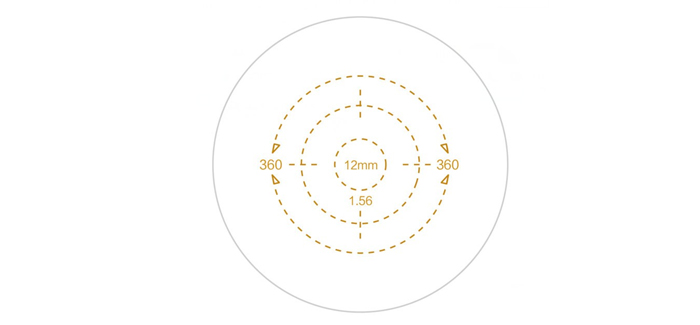
Myopia defocus control technology is the answer. Well from the pictures above you can find -- it can change the way light focuses on the retina between the central and peripheral retinal areas. Peripheral defocus theory suggests that this designs work at controlling myopia because they create that all important peripheral myopic defocus, interrupting the feedback loop for the eye to continue lengthening that is our bane in glasses and single vision lens wear.
(2) Central refractive correction technology
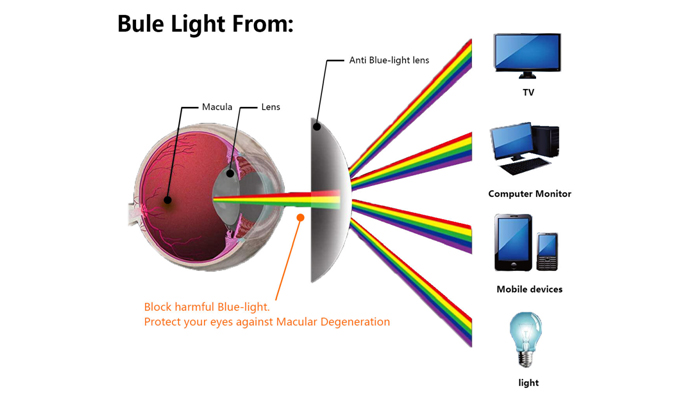
According to the imaging theory of emmetropia, the core optical zone of the YOULI myopia control lens is around 12mm, and the luminosity is basically not reduced. The retina forms a clear object image to achieve the refractive correction effect.According to the imaging theory of emmetropia, the core optical zone of the YOULI myopia control lens is around 12mm, and the luminosity is basically not reduced. The retina forms a clear object image to achieve the refractive correction effect.
(3) Does myopia control lens block blue light?
Blue light is divided into two parts: harmful blue light and beneficial blue light according to different wave bands. myopia control lens has intelligent blue light protection. It uses a substrate absorption technology to add a UV420 blue light absorption factor to the substrate to filter harmful blue light and retain beneficial blue light.
Features of myopia control lens
- 1. Center circle: photometric core area
- 2. Two circles and three circles: the gradual change area of light, the circle shows that our luminosity is decreasing in circle
- 3. 360: 360-degree diminishing luminosity change
- 4. 1.56/1.60: Refractive index
- 5. Great cross: not a horizontal reference line for processing, not an axis position, the luminosity changes to the surroundings
Precautions for fitting glasses
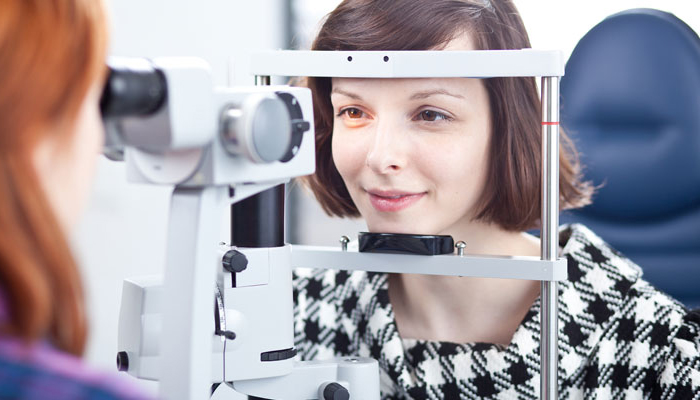
- 1. standardized optometry, optometry foot correction
- 2. Single pupil pupil distance and pupil height
- 3. The frame height is recommended to be 30mm-38mm, and the frame width is 45mm
- 4. Frame type FPD-PD<5mm
- 5. It is recommended to wear a nose pad, a frame with a small face bend and a small inclination angle
Precautions for wearing
- 1. Wearing full focus for the first time requires an adaptation period of less than 1 day, usually on the spot
- 2. Normally, the frame is well fixed, and no bad postures such as skew and glide
- 3. Regardless of nearsightedness or farsightedness, insist on long-term wear
- 4. Review the luminosity regularly, adjust the glasses and keep them comfortable to wear
- 5. While insisting on wearing all-focus glasses, you can also use other aids that are good for the eyes
Taking care of eyesight. Wearers should:
- 1. Spend more time outdoors, minimum 2 hours a day.
- 2. Take breaks from long intensive screen time or near-work.
- 3. Take note of ergonomics,such as proper lighting, posture, keeping the recommended working distance are very important to keep your eyes healthy while doing the near-work.
- 4. Get regular eye check-ups to ensure that myopia or other vision problems are detected and treated early, reducing the worsening of vision, myopia progression and potential complications of high myopia.
